●●●●
The Experience of Volatility in Low and Moderate-Income Households: Results From a National Survey
● Summary
This is the first in a series of briefs produced by a partnership between the Aspen Institute’s Expanding Prosperity Impact Collaborative (EPIC), Washington University’s Center for Social Development (CSD), and the Intuit Tax and Financial Center. It highlights new data on the prevalence of income and expense volatility in low- and moderate-income households. The second brief will focus on the downstream consequences of volatility and how it impacts financial behavior.
● Background
The Expanding Prosperity Impact Collaborative (EPIC), an initiative of the Aspen Institute’s Financial Security Program, is a first-of-its kind, cross-sector effort to shine a light on economic forces that severely impact the financial security of millions of Americans. EPIC deeply investigates one consequential consumer finance issue at a time.
EPIC’s first issue is income volatility, which destabilizes the budgets of nearly half of American households. Over the last year, EPIC has synthesized data, polled consumers, surveyed experts, published reports, and convened leaders, all to build a more accurate understanding of how income volatility affects low- and moderate-income families and how best to combat the most destabilizing dimensions of the problem.
● Issue Brief
INCOME VOLATILITY IN THE UNITED STATES
Families experience income and expense volatility when their cash inflows and outflows fluctuate over time, often in unpredictable ways. Volatility makes saving and asset building difficult, particularly in low-income households, for which one car accident or high-interest loan can create a cycle that potentially leads to unemployment or a debt spiral.
The purpose of this brief is to provide a high-level overview of month-to-month income and expense volatility in low- and moderate income (LMI) households. The brief draws upon the results of the 2016 Household Financial Survey (HFS), which was conducted as part of the Refund to Savings (R2S) Initiative. This survey is particularly valuable because it captures a wide array of financial metrics on a population often difficult to study on a large scale, and it also tracks these metrics over time.
Several recent studies have attempted to capture the prevalence of volatility. For example, Farrell and Greig of the JPMorgan Chase Institute analyzed millions of transactions from hundreds of thousands checking accounts, finding that, on average, sampled individuals experienced a 40% change in total income from month to month between 2013 and 2015. They also found that 55% of JPMorgan Chase’s customers regularly experienced more than a 30% change in income—up or down—from one month to the next. Median-income households in the study’s sample saw expenses fluctuate by 29% on a month-to-month basis. However, the sample was not limited to low-income households. The U.S. Financial Diaries, by contrast,meticulously tracked “every dollar spent, earned, borrowed, saved, and shared” in 235 LMI households over the course of a year, finding that, on average, households experienced 2.5 months more than 25% below their average income and 2.6 months more than 25% above it. Although the project has been deeply illuminating, the small sample limits how widely these findings can be generalized.
Other sources of volatility research include large-scale surveys like the HFS and the Federal Reserve’s annual Survey on Household Economics and Decisionmaking (SHED). Nearly a third of respondents in the 2015 SHED indicated that their income had “some unusually high or low months” or “[varied] quite a bit.” The HFS asks similar volatility questions but has several advantages, including a larger sample, a focus on LMI respondents, and—as will be explored in future briefs—a longitudinal component that enables us to track volatility metrics over time.
The brief will proceed as follows. First, we will describe the background, design, and methodology of the HFS. Next, we will highlight the prevalence of volatility in the income and expenses of the sample, exploring the interplay and overlap between these two forces in the lives of LMI American households. Finally, we will discuss the context and implications of the results.
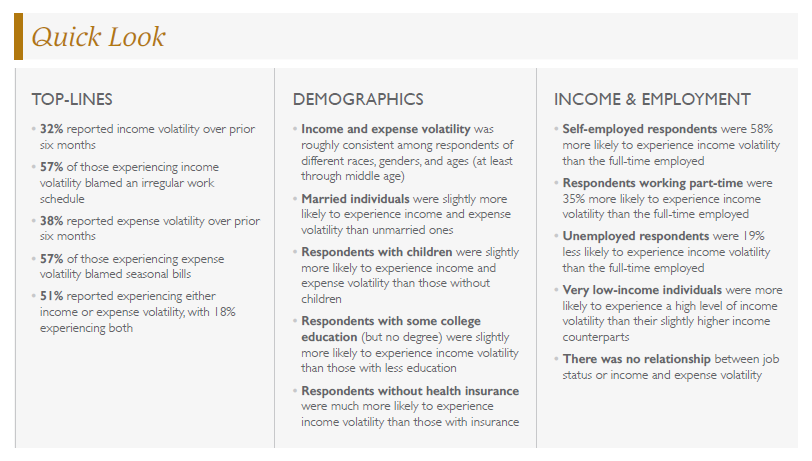
RESEARCH BACKGROUND & METHODOLOGY
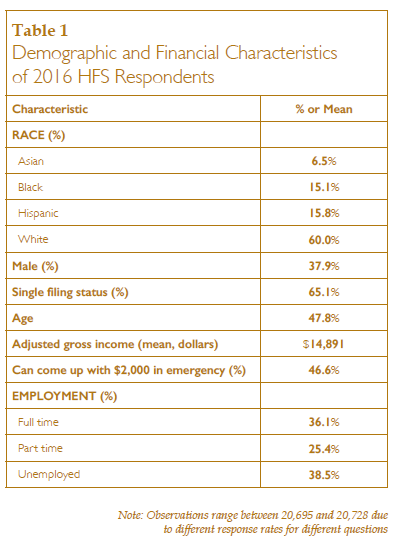
The data in this paper come from the 2016 iteration of the R2S Initiative, which uses behavioral economics to encourage LMI tax filers to save their tax refund when filing their taxes. The initiative is a collaboration among Washington University in St. Louis, Duke University, and Intuit Inc., the maker of TurboTax. Through an ongoing series of randomized, controlled trials, R2S tests the impact of behavioral interventions on users of the TurboTax Freedom Edition (TTFE) tax-filing software. The software is free to households that meet certain eligibility standards: In 2016, a household was required to have an adjusted gross income of $31,000 or less, be eligible for the Earned Income Tax Credit, or include a member who was on active military duty and have an adjusted gross income less than $61,000. A recent report on the R2S Initiative provides details on the study and its methods.
This analysis draws upon data from HFS, the survey component of R2S. The TTFE software invited a random selection of tax filers to participate in the survey at the completion of tax filing. With the tax filer’s consent, data from the survey were matched with the user’s tax return data collected in the TTFE software. The 2016 HFS analytical sample consisted of the 20,728 tax filers with a federal refund due from which CSD collected complete survey data and received the matching tax data. The analysis in this brief is descriptive and employs basic statistical tests to examine significant differences between groups. The survey results have been weighted using 2015 data from the Census Bureau’s American Community Survey. Because of these adjustments, HFS estimates are representative of LMI households in the United States. Table 1 outlines the weighted summary statistics of this sample.
The HFS measured respondents’ subjective perceptions of income and expense volatility with the following questions: “Which of the following best describes your household’s income over the last six months?” and “Which of the following best describes your household’s expenses over the last six months?” Three response options were offered with these questions: (a) “Roughly the same amount each month,” (b) “Roughly the same most months, but some unusually high or low months,” and (c) “Often varies quite a bit from one month to the next.” In the analyses reported here, the first response option is characterized as low volatility, the second is characterized as moderate volatility, and the third is characterized as high volatility.
RESULTS
THE EXPERIENCE OF VOLATILITY IN LMI HOUSEHOLDS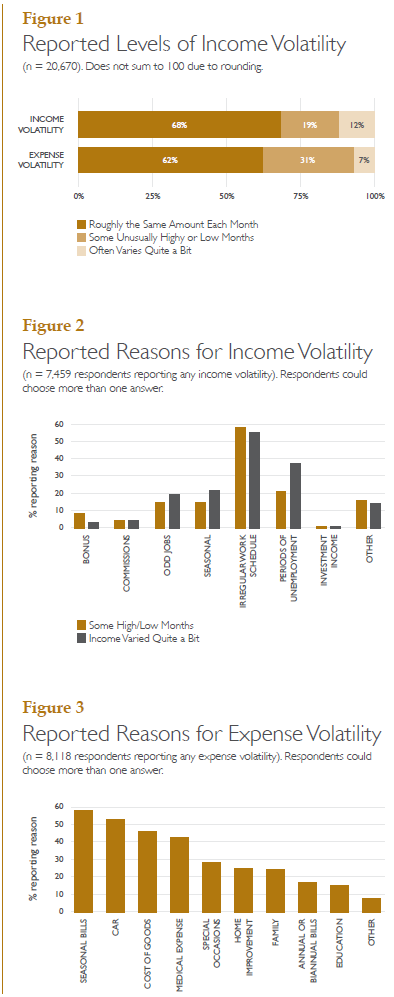
As Figure 1 illustrates, the 2016 HFS findings demonstrated a relatively high prevalence of income and expense volatility among LMI families. Roughly one third of respondents indicated that their household’s income had varied from month-to-month over the prior six months: 12% of respondents reported that income often varied considerably, and 19% reported that income was sometimes unusually high or unusually low. Interestingly, a higher percentage of households (38%) reported experiencing expense volatility, but a lower percentage (7%) reported that expenses varied considerably from month to month.
DRIVERS OF INCOME AND EXPENSE VOLATILITY
Figure 2 outlines the reasons respondents gave for experiencing volatile incomes. Far and away the most commonly cited reason for volatility was an irregular work schedule, which was reported by 55% of high income-volatility respondents. Periods of unemployment were cited by 37% of high-volatility respondents, and around a fifth of those respondents attributed income volatility to seasonal employment and to odd jobs.
Respondents were also asked about the causes of volatility in their expenses, and the results are illustrated in Figure 3. Seasonal bills, car costs, the cost of goods, and medical expenses were the most commonly cited drivers of expense volatility, with between 40% and 60% of respondents identifying each as a reason for expense volatility. Other drivers, such as special occasions, home improvement costs, and family-related expenses, were identified as reasons for volatility by over a fifth of respondents. Expense volatility can affect one’s ability to save money, and the HFS posed questions about this. Of the nearly 40% of respondents who reported moderate-to-high levels of expense volatility, a total of 68% reported that unexpected expenses made it hard to save with some regularity. Those respondents indicated that they found it difficult to save in some months, most months, or just about every month.
INTERPLAY BETWEEN INCOME AND EXPENSE VOLATILITY
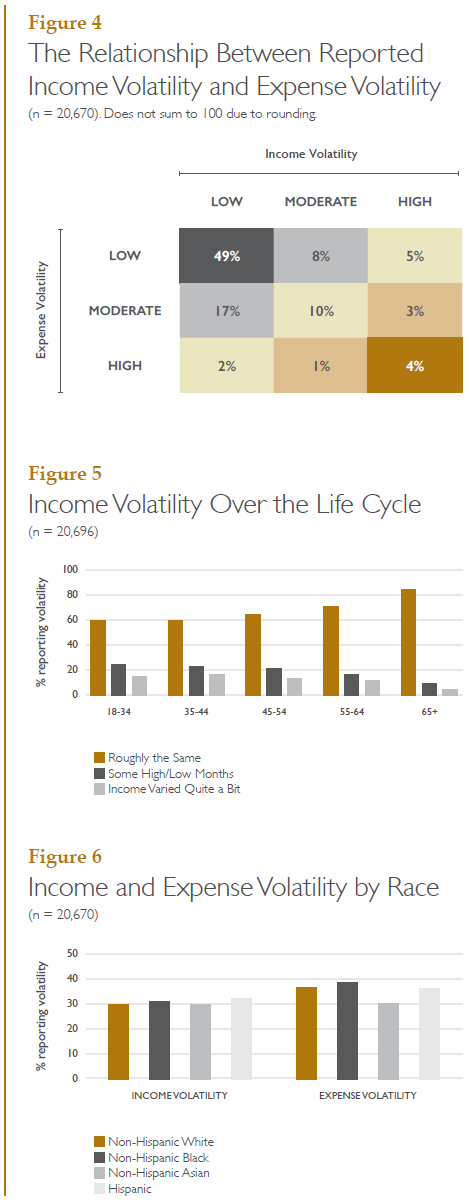
Figure 4 demonstrates that income and expense volatility are common in the lives of LMI households. Over half of respondents experienced some form of volatility, and almost one in five reported experiencing both kinds of volatility over the prior six months. It is possible that changes in income coincide with changes in expenses, which would make coping easier. Households may cut back on expenses after a job loss, for example. However, low-income households are unlikely to have access to the volatility mitigation resources, such as savings, credit, and insurance, that would enable them to smooth consumption during income drops or better manage expense spikes.
Although income and expense volatility were prevalent in the lives of this sample, only 4% of respondents reported experiencing both high income volatility and high expense volatility. However, experience of one kind of volatility is strongly correlated with experience of the other kind: 59% of households reporting high income volatility reported at least some expense volatility, and 67% of households reporting high expense volatility reported at least some income volatility.
WHO EXPERIENCES VOLATILITY?
While the overall prevalence of volatility is interesting, an examination of who experiences volatility is also illuminating. This section outlines how volatility varies across different demographic groups. Our analysis of who experiences volatility shows that it is surprisingly consistent and relatively low across age groups: At least 60% of respondents aged 18 to 54 reported that income was roughly the same each month (Figure 5), and expense volatility’s relationship with age, not featured here, follows a similar pattern.
These results run contrary to expectations about the evolution of income trends over the life cycle. We would expect younger respondents to experience more instability in job status, career, and geographical location; we would expect older respondents to experience more stability. Instead, middle-aged respondents experienced almost as much income volatility as younger ones, and income stability did not notably increase until respondents neared age 65. That increase was likely due to factors associated with retirement, such as an influx of steady Social Security income.
These results may be due in part to the nature of the sample. The HFS sample consists of LMI households. Households whose incomes become higher and more stable as they age will not be included in the sample if their increased incomes make them ineligible for the survey. This fact does not change the inference to be drawn from this result, however: Income volatility was a prominent factor in the lives of LMI households regardless of their age.
Figure 6 illustrates the relationship between volatility and race. Both income and expense volatility were roughly constant across Asian, Black, White, and Hispanic households. This indicates that—at least among LMI households—race and ethnicity may not be a strong driver of volatility.
Table 2 summarizes results on the prevalence of income and expense volatility across other key demographic groups. Many of the differences are statistically significant, but it is particularly notable that volatility occurred at relatively similar rates across many different demographic groups. Men and women did not differ much in their experiences with volatility, and neither did the married and unmarried. Households with children tended to report less stability in income and expenses than did those without children, but the differences were not stark. Interestingly, education appears to be positively correlated with volatility, though again the differences between the college graduates and nongraduates were not large. Individuals with some college accounted for the largest share of respondents reporting high income volatility, and this may speak to the fact that current students have somewhat unpredictable financial conditions. Of all the groups explored here, only those with and without health insurance differed substantially: Households lacking health insurance experienced high levels of income volatility at twice the rate of those with health insurance, and the uninsured households also reported higher rates of expense volatility.
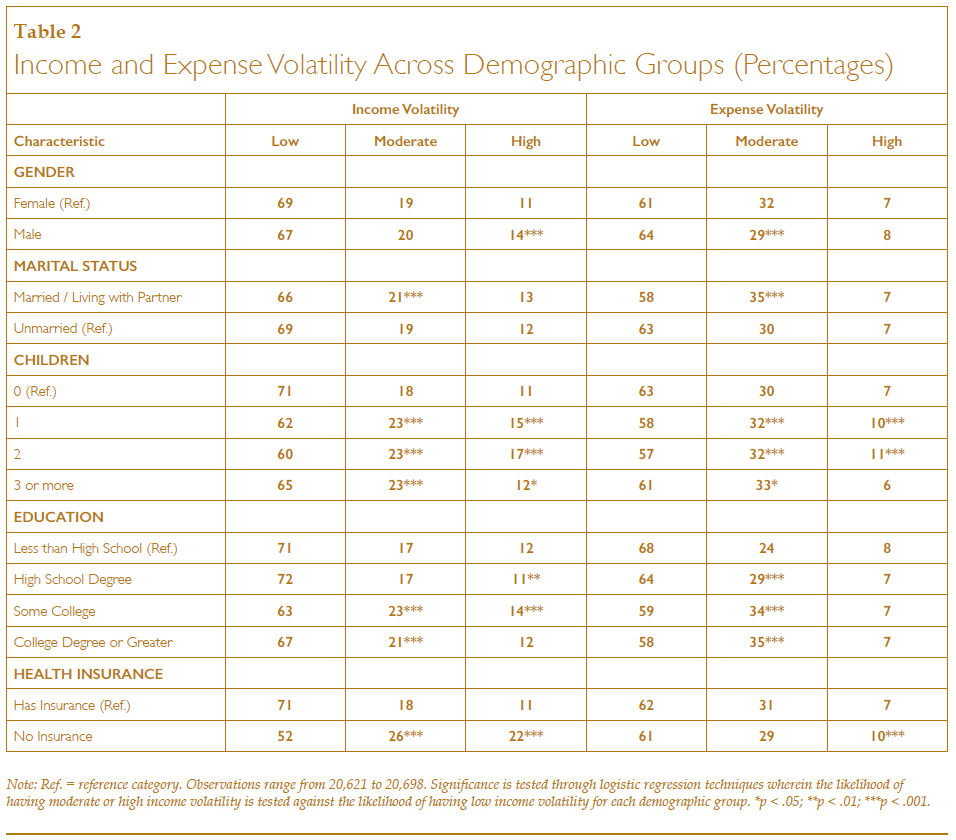
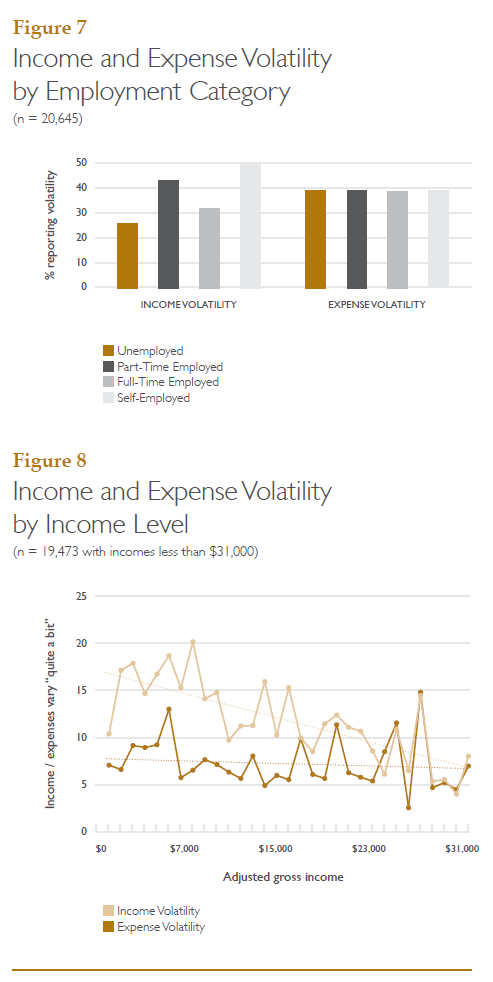
INCOME AND EMPLOYMENT CHARACTERISTICS OF HOUSEHOLDS EXPERIENCING VOLATILITY
One of the most striking results from the HFS was the difference in volatility levels between self-employed and full-time employees. As Figure 7 shows, almost half of self-employed LMI households experienced some form of income volatility, a rate almost 60% higher than that for households that reported full-time employment. Less dramatic but still significant was the difference in reported income volatility between respondents employed part time (42%) and those employed full time (31%). These differences are not altogether surprising since both the self-employed and part-timers often experience fluctuations in their work loads and pay. That said, working full time does not protect a person from volatility. Even people with steady jobs encounter income volatility. This speaks to the precariousness of today’s low-income jobs, which often fail to provide households with economic stability.
Interestingly, unemployed households reported the lowest rate of income volatility. The subjective volatility questions ask about volatility over the prior six months, and this finding may indicate that many of those reporting unemployment have been unemployed for an extended period; that is, they had no income (and thus no volatility) over that six-month period. There appears to be no relationship between job status and expense volatility.
Income and expense volatility also differed by the level of household income. Figure 8 illustrates this by plotting the percentage of households experiencing high income or expense volatility against household adjusted gross income. Income volatility was experienced at a higher rate in lower income households. Even in this sample, which is restricted to LMI households, income levels appeared to be associated with income volatility: Nearly 20% of those making less than $10,000 a year experienced high levels of income volatility. In comparison, fewer than 10% of those making over $30,000 experienced high income volatility.
Expense volatility does not appear to be correlated with income. However, expense shocks are likely larger as a proportion of household income for low-income families and are thus likely felt more intensely in those households.
VOLATILITY ACROSS THE UNITED STATES
Finally, Figure 9 illustrates the geographic distribution of high income volatility in this sample, showing that volatility does not follow a distinct geographic pattern. Rates of volatility were relatively low in the Midwest as a whole, particularly compared with parts of the Mountain West (i.e., South Dakota, North Dakota, and Idaho) and parts of New England (i.e., Maine and New Hampshire). Ultimately, this map seems to reveal that the experience with income volatility is something felt broadly across the United States.
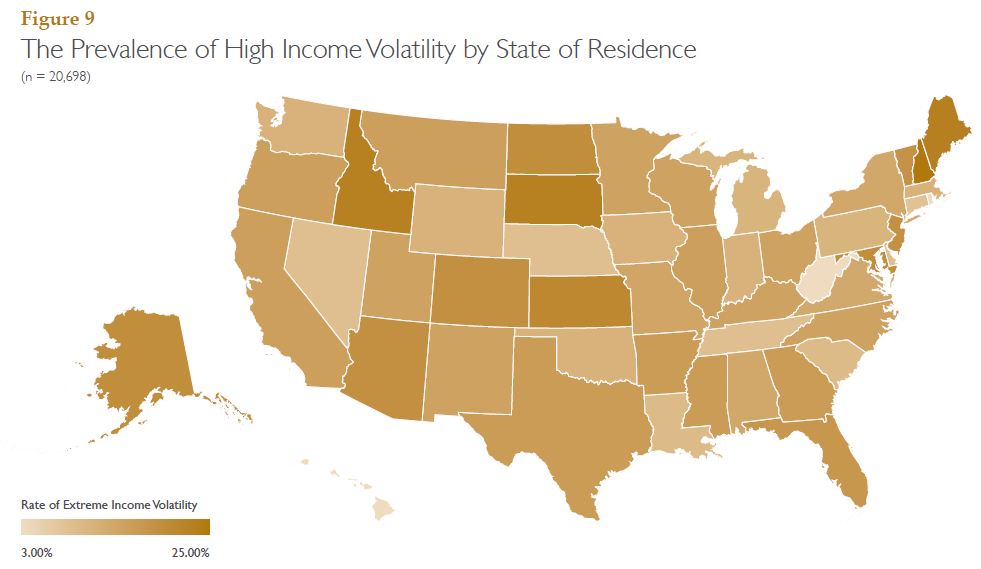
DISCUSSION
This brief highlights the prevalence of income and expense volatility among LMI households in the United States. Thirty-two percent of households reported moderate or high levels of income volatility, and that rate is comparable to the overall rate reported in the Federal Reserve’s SHED survey. This indicates that the prevalence of income volatility among LMI households may be quite similar to the prevalence of income volatility across the United States generally. However, we also found that income volatility within the sample was higher among the very low income and that such volatility decreased as income rose. That finding cuts against the view that volatility is experienced uniformly across the population. Furthermore, we should note that the SHED asks about volatility over the course of a year,
whereas HFS asks about it over the prior six months. Thus, LMI households in the HFS may have reported more volatility had they been prompted to consider their finances over a full year.
Of course, even if the prevalence of income volatility is the same among LMI households and households in the general population, it is likely that volatility does not have the same implications for LMI and non-LMI households. A non-LMI household experiencing a spike in expenses or a drop in income may be able to buffer these shocks by, for example, drawing down liquid assets, relying on credit lines, or simply weathering the spikes with their relatively high earnings. By contrast, LMI households are typically credit and asset constrained. Few make enough money to handle substantial shocks like large medical expenses.
Another striking result is the universality of income and expense volatility in LMI households, regardless of race, age (at least through middle age), gender, marital status, education, or geography. Indeed, respondents’ job status, income, and access to health insurance were the only major drivers of income volatility observed in this analysis. Although fairly dramatic, those relationships are not altogether surprising. Expense volatility, on the other hand, does not show a strong correlation with any of these factors.
Although this brief is focused on providing an overview of the LMI households affected by volatility rather than on an analysis of the effects of volatility, the finding that expense volatility makes it difficult for many families to save hints at the risks of volatility to LMI households. As volatility increases, the need for a financial buffer—savings, credit, or insurance—also increases, but the ability of LMI households to build these necessary cushions may well diminish.
There is reason to believe that volatility will grow worse in the future. Macroeconomic trends have resulted in both stagnating wages and an increase in part-time work, which leads to less predictable incomes and may hamper households’ ability to save for emergencies and other long-term goals. Additionally, increasing indebtedness, both from unsecured debt like credit cards and from long-term installment debt like nondischargeable student loans, may create a consistent drain on households’ incomes, limiting flexibility to handle job loss or wage reductions.
The next brief in this series will further examine the impacts of volatility on household well-being by exploring volatility’s relationships with such indicators of distress as material hardships, health care hardships, food insecurity, and the use of high-cost, short-term loans. To assess the behavioral correlates of unpredictable finances, we will also compare the financial habits of households that face volatility with those that do not. In addition, we will discuss potential solutions to the problem of volatility in LMI households. Our hope is that these results will add to the growing body of research showing that financial security should be defined not just by how much income is received but when it is received and that, for all too many Americans, volatile finances are the norm, not the exception.
DISCLAIMER
Statistical compilations disclosed in this document relate directly to the bonafide research of, and public policy discussions concerning savings behavior as it relates to tax compliance. Compilations are anonymous and do not disclose information containing data from fewer than 10 tax returns or reflect taxpayer-level data with the prior explicit consent from taxpayers. Compilations follow Intuit’s protocols to help ensure the privacy and confidentiality of customer tax data.
For Endnotes and Works Cited, please download the PDF version of this Issue Brief:
● Acknowledgments
The Center for Social Development at Washington University in St. Louis gratefully acknowledges the funders who made the Refund to Savings Initiative possible: the Ford Foundation; the Annie E. Casey Foundation; Intuit, Inc.; the Intuit Financial Freedom Foundation; and JPMorgan Chase Foundation. The Refund to Savings Initiative would not exist without the commitment of Intuit and its Tax and Financial Center, including the dedication of our collaborators, David Williams, Melissa Netram, Joe Lillie, Krista Holub, and many others on the Intuit team who have worked diligently in planning and implementing the experiment. Lastly, we thank the thousands of tax payers who consented to participate in the research surveys and shared their personal financial information.
The Aspen Institute Financial Security Program (FSP) gratefully acknowledges the funders who make the Expanding Prosperity Impact Collaborative possible: the Citi Foundation, the Ford Foundation, JP Morgan Chase & Co., Metlife Foundation, and the W.K. Kellogg Foundation. Aspen FSP would also like to thank Ida Rademacher, Joanna Smith-Ramani, and Katherine Lucas McKay for reviewing earlier drafts of this work and providing valuable feedback. The findings, interpretations, and conclusions expressed in this report – as well as any errors – are the authors alone and do not necessarily represent the view of the authors’ organizational affiliations, those organizations’ funders, or this paper’s reviewers.
Special thanks to the Intuit Tax & Financial Center for making the data available for this analysis.
●●●●
●●●●
EPIC is an initiative of the Aspen Institute's Financial Security Program.
CONTACT US:
The Aspen Institute
2300 N Street, NW Suite 700, Washington, DC 20037© The Aspen Institute 2017—All Rights Reserved





